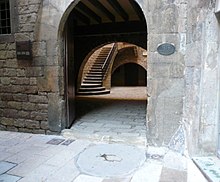Hiking Club of Catalonia

The Hiking Club of Catalonia (Catalan: Centre Excursionista de Catalunya) is a sporting and cultural organisation founded in 1876 and today offering services that include courses in mountaineering and organised hikes. The club also has a library of maps and photographs.
The Club was founded during a period known as, and by people involved in, the Catalan Renaissance, for the purposes of investigating the richness of Catalonia from the perspectives of science, literature and the arts.[1]
The Club was instrumental in promoting the Catalan language. In 1906 it organised the First International Congress on the Catalan Language. In 1907 it passed a resolution to create the Institute for Catalan Studies to pursue the study in a more academic way.
In order to explore Catalonia's architectural heritage, the architect and politician Lluís Domènech i Montaner visited the Valleys of Boí and Taüll near the border with Aragon in 1904, 1905 and 1906. In September 1907 the Institute for Catalan Studies and the Club organised a now famous archaeological mission to the area[2] bringing to light important churches and their frescoes, now the subject of a World Heritage Site. Amongst those who undertook the trip in 1907 was the influential architect, politician and art historian Josep Puig i Cadafalch who wanted to make an inventory of the architectural and artistic heritage of Catalonia.[3] Joana Vidal i Tarragó lectured them about folklore.[4]
After the Spanish Civil War, when it was prohibited to use Catalan in the public sphere, the Club was the first organisation to publicly teach in Catalan, using as a pretext the need to know the toponymy of Catalonia.
In 1999 the Club was awarded a UNESCO Medal.[5]
Notable members
[edit]- Pompeu Fabra (1868–1948), engineer and grammarian
- Norberto Font y Sagué (1874–1910), geologist, naturalist and writer
- Marcel·lí Gausachs (1891–1931), photographer
- Antoni Gaudí (1852 - 1926). Architect
References
[edit]- ^ "History of the Hiking Club of Catalonia" (in Catalan). Retrieved 2019-09-05.
- ^ "Romanesque Centre of the Boi Valley". Retrieved 5 September 2019.
- ^ "An exhibition titled Puig i Cadafalch and the romanesque of the Valley of Boí" (in Catalan). Government of Catalonia. Retrieved 18 September 2019.
- ^ Barcelona, Centre excursionista de Catalunya (1906). Butlletí del Centre Excursionista de Catalunya (in Catalan). Henrich y Compa. en Comandita.
- ^ "Centre Excursionista de Catalunya" [Hiking Club of Catalonia]. Encyclopedia Catalana (in Catalan). Grup Enciclopèdia Catalana. Retrieved 18 September 2019.
External links
[edit]Text is available under the CC BY-SA 4.0 license; additional terms may apply.
Images, videos and audio are available under their respective licenses.
